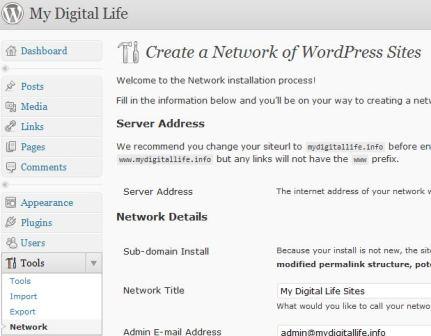One of the main feature in WordPress 3.0 is merging of the core of WordPress blogging engine and WordPress MU (WPMU), which is used to enable and support multi-user and multi-blog on a single WordPress installation. With the merging and integration of WP-MU and WordPress, the ability to create and run more than one or multiple blogs from one WordPress installation is now built-in by default.
However, has the multi-site feature built-in does not mean that the feature is enabled by default. In fact, the WordPress 3.0 multi-site feature is disabled by default. To enable the multi-site and multi-blog support, uses the following trick:
Edit wp-config.php file on the server with any text editor (e.g. vi), and add the following line of code anywhere in the file:
define(‘WP_ALLOW_MULTISITE’, true);
Save the edited wp-config.php file, and a new tab Tools -> Network will be accessible from within WordPress admin console, where webmaster can run the Network configuration wizard to create configuration files to enable a network of WordPress sites.

It’s best to install multi-site support for network of WordPress sites on new installation, although it’s also possible to convert existing installation into a WordPress network-supported site, though all sites in the WordPress network must use sub-domains, and the main site in a sub-directory install will need to use a modified permalink structure, potentially breaking existing links.
For new installation of multi-site enabled WordPress, administrators to choose to create blogs with URLs of either sub-domains or sub-directories, depending on web host support. For people who intends to map top-level domain names to blogs created on the single multi-site enabled WordPress networks (i.e. the blogs have own URL web address), WordPress MU Domain Mapping plugin is available, though the current version of plugin does not yet support WordPress 3.0. While waiting for the developer to officially release WordPress 3 supported plugin, the trunk branch of the plugin, however, contains fix to make the plugin works on WordPress 3.0. Follow instruction on readme.txt to install the plugin.

Once the installation of Network is completed, a new menu called Super Admin will be shown after user logs out and logs in again. Super Admin menu allows administrators to control and manage all sites on the network. Individual sites within the network can still access own admin dashboard and functions like typical normal WordPress site, by adding /wp-admin/ to the end of URL address.